(for why my prose style is so weird, and why it's followed with what looks like a bad French translation, see my first post here)
(and of course, read La Potiche's most recent post first, before reading mon flux de conscience)
Here's a statue, I think, on the Louvre. There are many statutes like this one on the Louvre, all with famous names: Montaigne, Cassini, Rousseau, Rabelais, and also yours, my readers, I swear it. But this statue is the only one wearing a net. For what crime, I ask myself? Is this evidence that punishments continue openly, despite the analyses of Foucault?
This is not such a stupid idea, nevertheless, I have another one, more amusing: thinking that the net is doing its best to stop the outflow of stones. According to Cohen, and according to geology also, even stones flow. The others without their own nets have soft surfaces. All the hazards of a wild life in the open air have made them multicolored. I chose to believe that the net is trying to do the impossible: to capture one statue, only one, to encourage it to remain itself.
Depuis deux ou trois ans, plus ou moins, mon ami Jeffrey Jerome Cohen écrit un livre au sujet de roches et de temps. Est-il possible pour un être humain, vivant pour peut-être quatre-vingts années, d'imaginer le temps des pierres, qui durent à travers le temps qui semble, à nous, une éternité ? Toutefois, à l'univers, les pierres durent quelques instants courts entre deux abîmes, le noir et le chaud, la terminaison et le commencement de toutes choses. Trop longs et trop courts, les roches échappent et se cachent. Donc, le livre sera difficile, lente, et sûrement dur...comme les autres.
Voilà une statue, je crois, sur le Louvre. Il y a beaucoup de statues comme celle-ci sur le Louve, toutes avec les noms célébrés : Montaigne, Cassini, Rousseau, Rabelais, et aussi le vôtre, mes lecteurs, je le jure. Mais cette statue est la seule qui porte un filet. Pour quelle félonie, je me demande ? Est-il l'évidence que les punitions continuent ouvertement, malgré les analyses de Foucault ?
Ce n'est pas une idée trop bête, néanmoins j'ai une autre plus amusante : penser que le filet fait de son mieux d'arrêter l'écoulement des pierres. Après Cohen, et après la géologie aussi, même les pierres coulent. Les autres sans les propres filets ont des surfaces mouillées. Tous les hasards de la vie sauvage en plein air les bariolaient. Je choisis croire que le filet essaie de faire l'impossible : capturer une statue, seulement une, pour l'encourager à rester soi-même.


Un poème coulant... Haunted by this; well done.
ReplyDeletecheers! hope it was worthy of your project.
ReplyDeleteI love your translation back to anglais.
ReplyDeletec'est bizarre, n'est-ce pas?
ReplyDelete